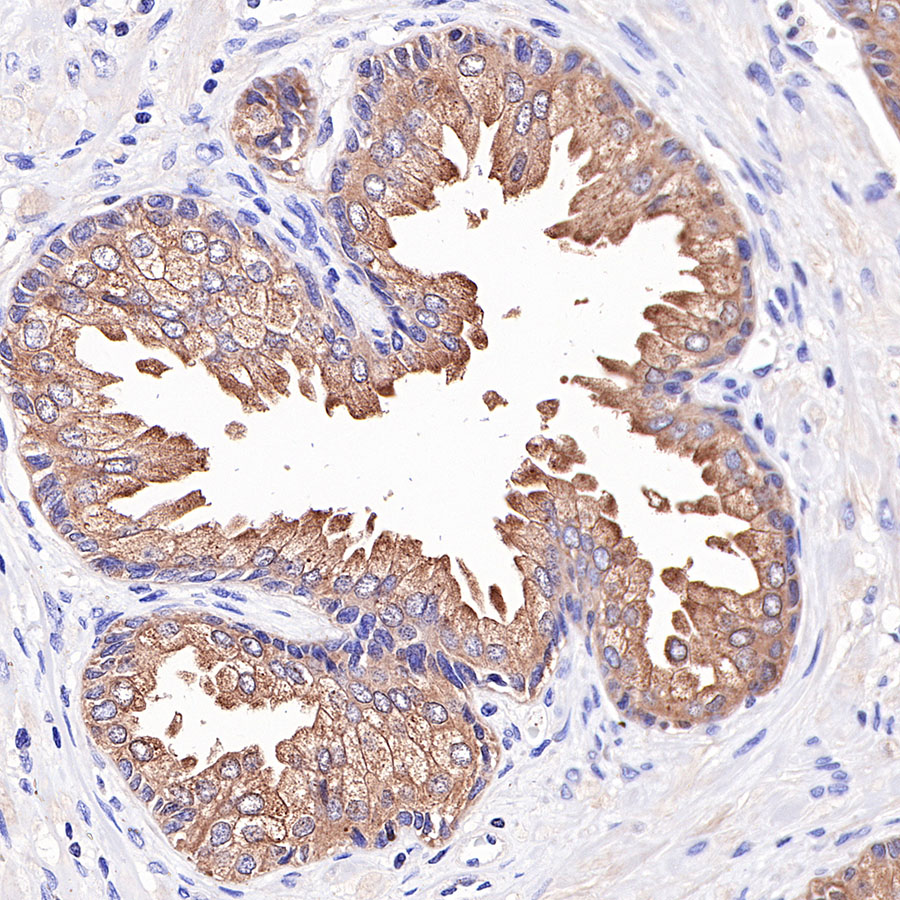Rabbit anti-PAP Recombinant Monoclonal Antibody(354-18)别名宿主反应种属应用免疫原形式浓度纯化方法类型克隆号储存/保存方法存储溶液背景说明细胞定位UniProt
| 概述 | |
| 别名 |
Prostatic acid phosphatase; PAP-P; PASE/4LJ; Acid phosphatase 3; Ecto-5′-nucleotidase; Protein tyrosine phosphatase ACP3; Thiamine monophosphatase; TMPase
|
| 宿主 |
Rabbit
|
| 反应种属 |
Human
|
| 应用 |
IHC-P: 1:2000
|
| 免疫原 |
Recombinant protein
|
| 性能 | |
| 形式 |
Liquid
|
| 浓度 |
0.125 mg/mL
|
| 纯化方法 |
Protein A affinity column
|
| 类型 |
Monoclonal Antibody
|
| 克隆号 |
354-18
|
| 储存/保存方法 |
Store at -20℃ for one year.
|
| 存储溶液 |
PBS, 40% Glycerol, 0.05% BSA, 0.03% Proclin 300
|
| 靶标 | |
| 背景说明 |
Prostatic acid phosphatase (PAP) is the most abundant phosphatase in human prostate tissue/secretions. It is a clinically important protein for its relevance as a biomarker of prostate carcinoma. PAP has phosphatase activity and is an extensively studied biomarker of prostate cancer. The major action of PAP is to dephosphorylate macromolecules with the help of catalytic residues (His(12) and Asp(258)) that are located in the cleft between two domains [PMID: 20645695].
|
| 细胞定位 |
Secreted
|
| UniProt |
P15309
|
实验结果图

IHC shows positive staining in paraffin-embedded human prostate. Anti-PAP antibody was used at 1/2000 dilution, followed by a HRP Polymer for Mouse & Rabbit IgG (ready to use). Counterstained with hematoxylin. Heat mediated antigen retrieval with Tris/EDTA buffer pH9.0 was performed before commencing with IHC staining protocol.

IHC shows positive staining in paraffin-embedded human prostate cancer. Anti-PAP antibody was used at 1/2000 dilution, followed by a HRP Polymer for Mouse & Rabbit IgG (ready to use). Counterstained with hematoxylin. Heat mediated antigen retrieval with Tris/EDTA buffer pH9.0 was performed before commencing with IHC staining protocol.

Negative control: IHC shows negative staining in paraffin-embedded human kidney. Anti-PAP antibody was used at 1/2000 dilution, followed by a HRP Polymer for Mouse & Rabbit IgG (ready to use). Counterstained with hematoxylin. Heat mediated antigen retrieval with Tris/EDTA buffer pH9.0 was performed before commencing with IHC staining protocol.
